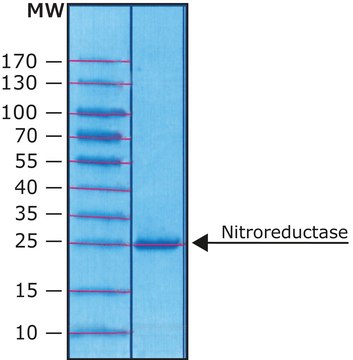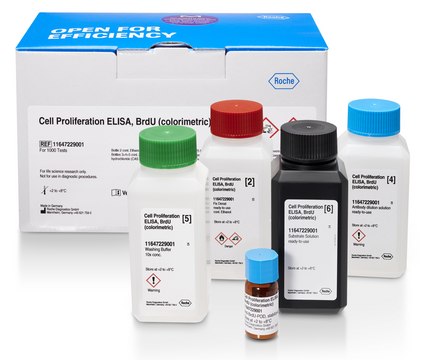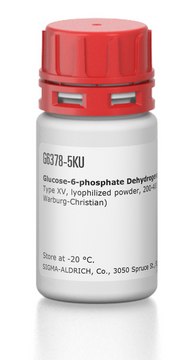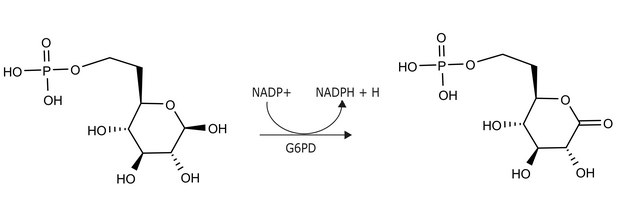10981249001
Roche
Nitrate Reductase
from Aspergillus species
Sign Into View Organizational & Contract Pricing
All Photos(1)
Recommended Products
form
lyophilized
specific activity
~0.4 units/mg protein (At 25 °C with nitrate as the substrate.)
packaging
pkg of 20 U
manufacturer/tradename
Roche
shipped in
wet ice
storage temp.
−20°C
General description
Nitrate reductase contains molybdenum as a cofactor and belongs to the family of dimethyl sulfoxide reductase. It is localized in periplasm, cytoplasm, and cell membrane.
Application
- Nitrate Reductase is used for nitrate determination:Assay of nitrite and nitrate in culture media.
- Determination of NO3− in serum.
It was used to reduce nitrate to nitrite which will help in determination of nitric oxide metabolites levels in tissue using spectrophotometric methods.
Nitrate reductase has been used to determine nitric oxide activity by measuring its stable metabolites, nitrate and nitrite upon reduction.
Biochem/physiol Actions
Nitrate reductase is the first enzyme in nitrate assimilation pathway. During reduction of nitrate to nitrite, it uses pyridinenucleotides, flavin, or benzyl viologen as electron donors. It acts as central point for integration of metabolism by monitoring flux of reduced nitrogen in plants, algae and fungi. In plants, nitrate reductase is regulated by a number of factors, such as nitrate, metabolites, dropdown in temperature, phytohormones, drought and light.
Quality
Contaminants: <0.5% “NADPH oxidase”, <0.8% NAD(P)H-dependent ADH, <0.15% nitrite reductase
Preparation Note
Working concentration: Nitrate determination using Nitrate reductase:
The concentration of NADPH is 200 to 250 μmol/ml in the assay. This guarantees the function of the assay with regard to the stability of NADPH in the kit. This is the highest possible NADPH concentration for measuring an accurate E1.
Assay for the activity of Nitrate reductase:
Optimal NADPH concentration is 600 μmol/l and 5 μmol/l additional FAD is sufficient for the assay as the enzyme contains already FAD.
Storage conditions (working solution): A solution of 20 U Nitrate reductase in 2 ml double-dist. water is stable for one week when stored at 2 to 8 °C; for longer periods, freeze the solution in aliquots.
Nitrate Reductase is shipped at 15 to 25 °C.
Note: Avoid repeated thawing and freezing.
The concentration of NADPH is 200 to 250 μmol/ml in the assay. This guarantees the function of the assay with regard to the stability of NADPH in the kit. This is the highest possible NADPH concentration for measuring an accurate E1.
Assay for the activity of Nitrate reductase:
Optimal NADPH concentration is 600 μmol/l and 5 μmol/l additional FAD is sufficient for the assay as the enzyme contains already FAD.
Storage conditions (working solution): A solution of 20 U Nitrate reductase in 2 ml double-dist. water is stable for one week when stored at 2 to 8 °C; for longer periods, freeze the solution in aliquots.
Nitrate Reductase is shipped at 15 to 25 °C.
Note: Avoid repeated thawing and freezing.
Other Notes
For life science research only. Not for use in diagnostic procedures.
Signal Word
Danger
Hazard Statements
Precautionary Statements
Hazard Classifications
Resp. Sens. 1
WGK
WGK 2
Flash Point(F)
does not flash
Flash Point(C)
does not flash
Regulatory Information
常规特殊物品
Certificates of Analysis (COA)
Search for Certificates of Analysis (COA) by entering the products Lot/Batch Number. Lot and Batch Numbers can be found on a product’s label following the words ‘Lot’ or ‘Batch’.
Already Own This Product?
Find documentation for the products that you have recently purchased in the Document Library.
Structural and mechanistic insights on nitrate reductases.
Coelho C and Romao M J
Protein Science, 24(12), 1901-1911 (2015)
Aysegul Keser et al.
Neuroscience letters, 545, 102-106 (2013-05-07)
Nicotine addiction is a serious health problem resulting in millions of preventable deaths worldwide. The gas messenger molecule nitric oxide (NO) plays a critical role in addiction, and nicotine increases nitric oxide metabolites (NOx) in the brain. Understanding the factors
Nitrate reductase from higher plants.
Hageman, R. H., and D. P. Hucklesby
Methods in Enzymology, 23, 491-503 (1971)
Lorena Olivares-González et al.
Frontiers in nutrition, 9, 847910-847910 (2022-04-08)
Oxidative stress plays a major role in the pathogenesis of retinitis pigmentosa (RP). The main goal of this study was to evaluate the effect of 2-year nutritional intervention with antioxidant nutraceuticals on the visual function of RP patients. Secondly, we
Anna Zalewska et al.
Scientific reports, 11(1), 23904-23904 (2021-12-15)
Alzheimer's disease (AD) is associated with the deposition of β-amyloid in the brain. AD accounts for over 50% of cases of dementia which results from disturbances in redox homeostasis. Indeed, increased intensity of protein oxidation and nitration as well as
Our team of scientists has experience in all areas of research including Life Science, Material Science, Chemical Synthesis, Chromatography, Analytical and many others.
Contact Technical Service






